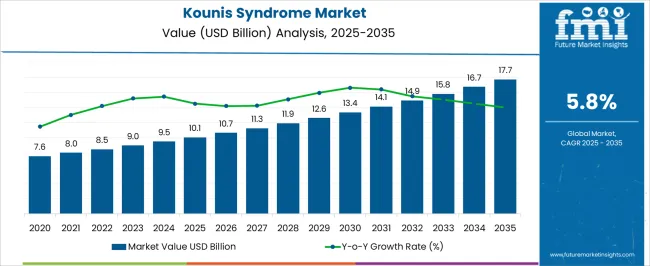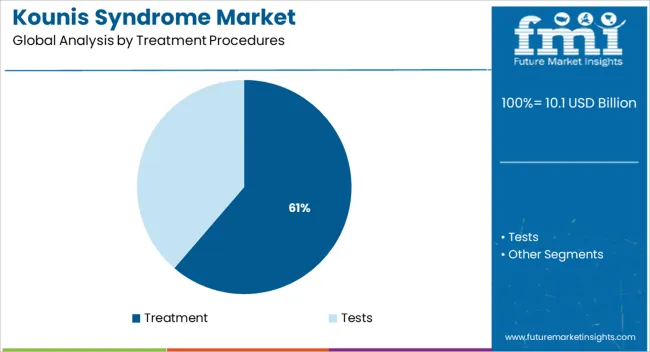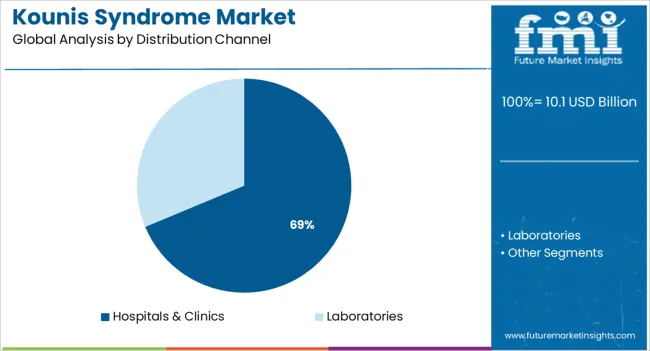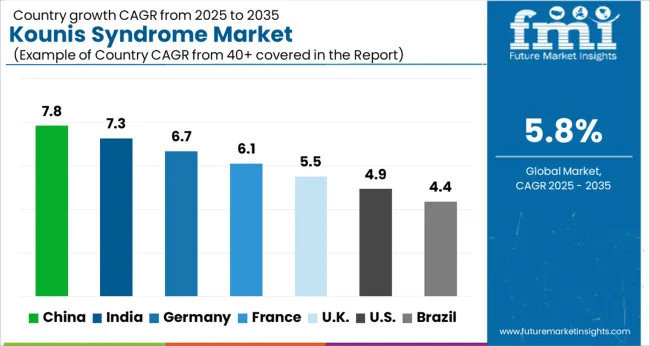The Kounis Syndrome Market is estimated to be valued at USD 10.1 billion in 2025 and is projected to reach USD 17.7 billion by 2035, registering a compound annual growth rate (CAGR) of 5.8% over the forecast period.

| Metric | Value |
|---|---|
| Kounis Syndrome Market Estimated Value in (2025 E) | USD 10.1 billion |
| Kounis Syndrome Market Forecast Value in (2035 F) | USD 17.7 billion |
| Forecast CAGR (2025 to 2035) | 5.8% |
The Kounis Syndrome market is witnessing growing attention driven by the increasing incidence of allergic reactions and cardiovascular complications that converge in acute care settings. Clinical journals and cardiology conference presentations have highlighted the underdiagnosis of Kounis Syndrome, leading to a renewed focus on improved diagnostic awareness and integrated treatment protocols.
The growing prevalence of comorbid conditions such as asthma, allergic rhinitis, and coronary artery disease has further emphasized the need for prompt and specialized management. Cardiovascular health programs and emergency care units are being equipped with advanced diagnostic tools and treatment guidelines, allowing for faster intervention and improved outcomes.
Future growth is expected to be shaped by research collaborations focusing on mast cell activation and allergic response pathways, as well as rising healthcare infrastructure investments in emerging markets As clinical awareness continues to improve, the market is likely to benefit from enhanced treatment precision, patient education, and a greater emphasis on allergen avoidance strategies in cardiac care settings.
The market is segmented by Treatment Procedures and Distribution Channel and region. By Treatment Procedures, the market is divided into Treatment and Tests. In terms of Distribution Channel, the market is classified into Hospitals & Clinics and Laboratories. Regionally, the market is classified into North America, Latin America, Western Europe, Eastern Europe, Balkan & Baltic Countries, Russia & Belarus, Central Asia, East Asia, South Asia & Pacific, and the Middle East & Africa.

The treatment segment is projected to account for 61.3% of the Kounis Syndrome market revenue share in 2025, positioning it as the leading procedural category. This dominance is being driven by the immediate need for medical intervention once an allergic cardiac episode is detected, as highlighted in cardiology practice guidelines and emergency care recommendations. Clinical protocols emphasize rapid stabilization through antihistamines, corticosteroids, and vasodilators, which has reinforced the demand for standardized treatment pathways.
Hospitals and acute care centers have been observed to rely heavily on pharmacological treatments that are well-documented to reduce inflammation and manage vasospastic effects. The integration of these therapies into existing cardiovascular emergency protocols has facilitated faster response times and improved survival rates.
As awareness of Kounis Syndrome grows among healthcare professionals, treatment is being prioritized to reduce recurrence and prevent complications, which in turn supports the segment’s sustained growth The reliability, accessibility, and proven clinical outcomes associated with available treatments are key factors contributing to its leading market share.

The hospitals and clinics segment is expected to dominate the Kounis Syndrome market by contributing 68.7% of revenue share in 2025. This leadership is attributed to the critical role of these facilities in diagnosing and managing acute allergic cardiovascular events. Emergency departments within hospitals are typically the first point of contact for patients experiencing symptoms of Kounis Syndrome, leading to high treatment volumes within these settings.
Healthcare infrastructure reports and clinical news sources have indicated that hospitals are increasingly equipped with the necessary diagnostic tools and multi-disciplinary teams required to manage this complex condition. Clinics, particularly those affiliated with cardiac care networks, are also being utilized for follow-up care and allergen assessment, ensuring continuity in patient management.
Furthermore, advancements in in-hospital allergy testing and cardiac imaging have contributed to early detection, allowing for more effective treatment planning The combination of critical care capabilities, access to trained specialists, and integration of treatment protocols has positioned hospitals and clinics as the primary channel for managing this rare but serious condition.
According to market research and competitive intelligence provider Future Market Insights- the market for Kounis syndrome reflected a value of 4.1% during the historical period, 2020 to 2025.
The number of elderly people reporting respective cardiovascular diseases is high. Owing to this, it is anticipated that the ever-increasing geriatric population, which is expected to rise in future years worldwide mainly in the Middle East and Africa & Asia-Pacific region, creates an opportunity for market growth in the forecast period. In addition, the integration of technological advancements for manufacturing medication to treat kounis syndrome is expected to boost the growth of the market.
Thus, the market for Kounis syndrome is expected to register a CAGR of 5.8% in the forecast period 2025 to 2035.
Research and development of medication and treatment supporting market growth
The rise in the prevalence of chronic diseases, such as coronary artery disease, ischemic heart disease, and vascular diseases the key reason for the growth of the kounis syndrome market. As the companies are constantly engaged in research and developmental activities, the knowledge about the prevalence of chronic heart and vascular diseases would help in finding novel solutions, and developing the cardiology and vascular devices would aid in more collaborations and partnerships with market players in the US, Europe, and Asia Pacific region.
This signifies that the increase in research and development investment for the discovery and development of treatments for kounis syndrome boosts the market growth.
Wide range of products offered by market players boosting Kounis syndrome market growth
Strategic product launches and collaborations done by major companies in interventional cardiology and peripheral vascular devices have opened up an opportunity to expand their business in various regions.
This strategy is allowing the companies to strengthen their footprints in the market. Therefore, it is predicted that strategic initiative is the golden opportunity for the market players to accelerate their revenue growth in the market.
The surge in technological advancements for cardiovascular disease creates lucrative opportunities for Kounis syndrome market
As technology advances rapidly, it improves how one manages cardiovascular diseases. In addition, recent healthcare monitoring applications and gadgets have enhanced the connection between patients and healthcare providers to update treatment plans and improve health outcomes. Thus, this is expected to create a significant opportunity for the global kounis market in the forecast period.
Also, governments in emerging markets (China, Brazil, Russia, India, and South Africa) reform public healthcare and grant more accessible access to medicine. These two factors working in unison mean greater freedom for market developments and increased innovation in clinical research in emerging markets.
Expensive nature of treatment and cardiology devices hampering the overall market growth
The rise in the cost of therapeutic surgery and the lack of accessibility to disease management services and support in low-economic countries are the restraints and challenges for the growth of kounis syndrome market.
The increased intricacy and cost of the cardiology devices and robust investments would increase the costs. The increased cost would result in delayed treatment of the patients in hospitals and clinics and clearance of this product is very rigorous and time-consuming many of the products find it difficult to get approved due to not complying with the regulations which may hamper the market growth.

Research and development activities finding novel solutions for the treatment of kounis syndrome
The major factor driving the growth of the kounis syndrome market rises in the prevalence of chronic diseases along with the growing geriatric population, and the wide range of products offered by market players leading the kounis syndrome market to grow in the future.
As the companies are constantly engaged in research and developmental activities, the knowledge about the prevalence of chronic heart and vascular diseases would help in finding novel solutions, and developing the cardiology and vascular devices would aid in more collaborations and partnerships with market players in the USA, Europe, and Asia Pacific region.
This signifies that the increase in research and development investment for the discovery and development of treatments of kounis syndrome boosts the market growth. Thus, North America is expected to possess a 40% market share of kounis syndrome market in 2025.
Lifestyle changes increasing the risk of kounis syndrome in Asia Pacific
ESCAP suggests that Asia Pacific is aging faster than any other region in the world. This, in turn, increases the number of people suffering from ailments in the Asia Pacific region. Fast-paced and sedentary lifestyles in the Asia Pacific region in countries like India, China, and Japan are increasing the prevalence of kounis syndrome
Furthermore, an increase in smoking, hypertension, diabetes, hyperlipidemia, physical inactivity, family obesity, and poor nutritional practices are other key factors leading to the growth of kounis syndrome in the Asia Pacific region. Thus, Asia Pacific is expected to possess a 36% market share of kounis syndrome market in 2025.
Favorable reimbursement policies make hospitals a viable option for treatment
On the basis of distribution channel, the kounsin syndrome market is segmented into Laboratories Hospitals & Clinics
The hospital segment is expected to hold the largest market share for kounis syndrome. This is owing to the availability of various treatments and diagnostics in hospitals. In addition, the presence of healthcare experts and cardiologists is playing a key role in the wide usage of hospitals for the treatment of kounis syndrome.
In addition, initiatives by government authorities to support the treatment of kounis syndrome, especially in hospitals are favoring the growth of the same. Moreover, reimbursement schemes and their benefits are making hospitals a go-to option for the treatment of kounis syndrome. Thus, hospitals and clinics are expected to hold a 55% market share of kounis syndrome market in 2025.
Key start-up players in the kounis syndrome market are CardioDX, Verily, CVRX, BlueRock Therapeutics, CARMAT, and Cleerly

Key players in the kounis syndrome market are Jordan Hospital & Medical Center, Fortis Hospital Anandapur, Samsung Medical Center, Hospital Mae de Deus, Premier Medica, National Taiwan University Hospital, Muro General Hospital, Herzinstitut Berlin, Kyung Hee University Hospital, HELIOS Dr. Horst Schmidt Hospital Wiesbaden
| Report Attribute | Details |
|---|---|
| Market Value in 2025 | USD 10.1 billion |
| Market Value in 2035 | USD 17.7 billion |
| Growth Rate | CAGR of 5.8% from 2025 to 2035 |
| Base Year for Estimation | 2025 |
| Historical Data | 2020 to 2025 |
| Forecast Period | 2025 to 2035 |
| Quantitative Units | Revenue in USD Million and CAGR from 2025 to 2035 |
| Report Coverage | Revenue Forecast, Volume Forecast, Company Ranking, Competitive Landscape, Growth Factors, Trends, and Pricing Analysis |
| Segments Covered | Treatment Procedure, Distribution Channel, Region |
| Regions Covered | North America; Latin America; South Asia; East Asia; Oceania; Middle East & Africa (MEA) |
| Key Countries Profiled | The USA, Canada, Brazil, Argentina, Germany, The UK, France, Spain, Italy, Nordics, BENELUX, Australia & New Zealand, China, India, Association of Southeast Asian Nations, GCC, South Africa |
| Key Companies Profiled | Jordan Hospital & Medical Center; Fortis Hospital Anandapur; Samsung Medical Center; Hospital Mae de Deus; Premier Medica; National Taiwan University Hospital; Muro General Hospital; Herzinstitut Berlin; Kyung Hee University Hospital; HELIOS Dr. Horst Schmidt Hospital Wiesbaden |
| Customization | Available Upon Request |
The global kounis syndrome market is estimated to be valued at USD 10.1 billion in 2025.
The market size for the kounis syndrome market is projected to reach USD 17.7 billion by 2035.
The kounis syndrome market is expected to grow at a 5.8% CAGR between 2025 and 2035.
The key product types in kounis syndrome market are treatment, _beta-lactam antibiotics, _non-steroidal anti-inflammatory drugs, _rocuronium, _others, tests, _blood tests, _chest x-ray, _ecg, _ekg, _mri and _angiography.
In terms of distribution channel, hospitals & clinics segment to command 68.7% share in the kounis syndrome market in 2025.






Full Research Suite comprises of:
Market outlook & trends analysis
Interviews & case studies
Strategic recommendations
Vendor profiles & capabilities analysis
5-year forecasts
8 regions and 60+ country-level data splits
Market segment data splits
12 months of continuous data updates
DELIVERED AS:
PDF EXCEL ONLINE
WHIM Syndrome Management Market Insights and Analysis for 2025 to 2035
Marfan Syndrome Management Market Size and Share Forecast Outlook 2025 to 2035
Laband Syndrome Therapeutics Market Growth - Trends & Future Innovations 2025 to 2035
Dry Eye Syndrome Treatment Market Size and Share Forecast Outlook 2025 to 2035
Donohue Syndrome Treatment Market Growth - 2025 to 2035.
Triple X Syndrome Management Market Size and Share Forecast Outlook 2025 to 2035
Barlow’s Syndrome Market Size and Share Forecast Outlook 2025 to 2035
Edward’s Syndrome Treatment Market – Growth & Future Prospects 2025 to 2035
Sjogren's Syndrome Market Size and Share Forecast Outlook 2025 to 2035
Global Takotsubo Syndrome Therapeutics Market Analysis - Size, Share & Forecast 2025 to 2035
Carcinoid Syndrome Management Market
Carcinoid Syndrome Diarrhea Treatment Market
Short sleep syndrome Treatment Market Growth & Demand 2025 to 2035
Klinefelter Syndrome Therapeutics Market - Growth & Demand 2025 to 2035
Central Pain Syndrome Management Market – Size, Share & Growth 2025 to 2035
Acrocallosal Syndrome Therapeutics Market - Trends & Future Growth 2025 to 2035
Adrenogenital Syndrome Treatment Market Size and Share Forecast Outlook 2025 to 2035
Aarskog-Scott Syndrome Treatment Market - Growth & Innovations 2025 to 2035
Andersen-Tawil Syndrome Treatment Market Trends - Growth & Future Prospects 2025 to 2035
Myelodysplastic Syndrome Treatment Market Size and Share Forecast Outlook 2025 to 2035

Thank you!
You will receive an email from our Business Development Manager. Please be sure to check your SPAM/JUNK folder too.
Chat With
MaRIA